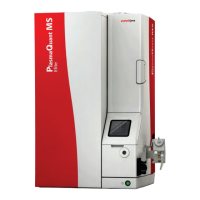Troubleshooting PlasmaQuant MS product family
128
If the process fails after re-setting the resolution, then click the [D
EFAULTS] button
to restore the default values set by the Analytik Jena service personnel during the
last installation or service, and repeat the resolution and trim routine.
After the resolution and trim has been reset, you must perform a mass calibration
again.
If no significant sensitivity is observed for selected isotope/s when running the
detector calibration, then check the following (see also section "Attenuation factors
calibration troubleshooting" p. 95):
Inspect the sample introduction system and ensure that the testing solution is
pumped into the spray chamber and the solution waste from the spray chamber is
drained out properly.
Make sure that a correct detector calibration solution is prepared and used. The
solution must contain the isotope/s selected for the attenuation factor calibration
(see section "Instrument initialization and solution preparations" p. 88).
Ensure that a correct worksheet is selected and re-tune the method parameters (if
necessary) to achieve an adequate sensitivity for the selected isotope/s, typically
over 10,000 c/s per isotope (see section "Detector calibration worksheet" p. 89).
If no detector attenuation factor is calibrated for some selected isotopes:
Un-calibrated attenuation factor is often due to a detector over-range. Open the
detector calibration worksheet, start the time scan from the method optimization
page, and ensure that the sensitivity for the isotope of interest is not over-ranged;
if required, re-tune the instrument or, if necessary, dilute the appropriate
calibration solution.
If the RSD for some of the factors are poor, typically over 5 %:
Ensure that the instrument achieved an adequate sensitivity for the selected
isotope/s, typically over 10,000 c/s per isotope.
Make sure the dwell time and scans per replicate are set up properly. It is
recommended to use 50,000 µs dwell time per isotope and use 50 scans per
replicate. Also, set the number of detector calibrations to be five from the detector
calibration page.
If the iCRC system is going to be used for analysis, it is recommended to warm up the
instrument using a time scan as you normally would, but to do so using a worksheet
that has a iCRC flow enabled. This helps the system stabilize before you start your
analysis. A time scan running for ~15 min adequately stabilizes the system before use.
Detector Attenuation

